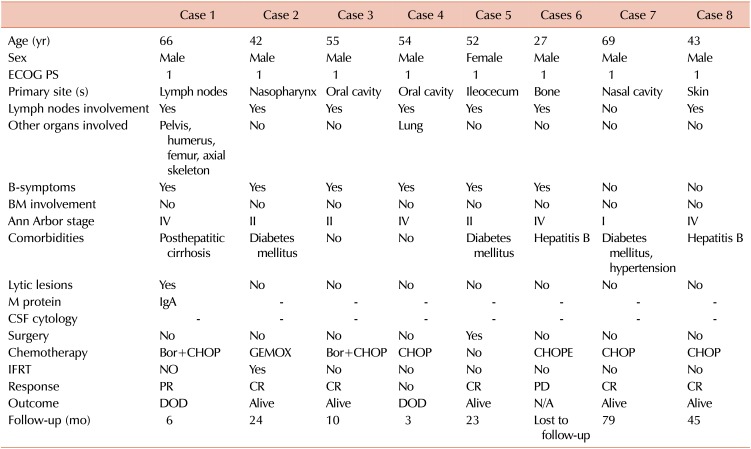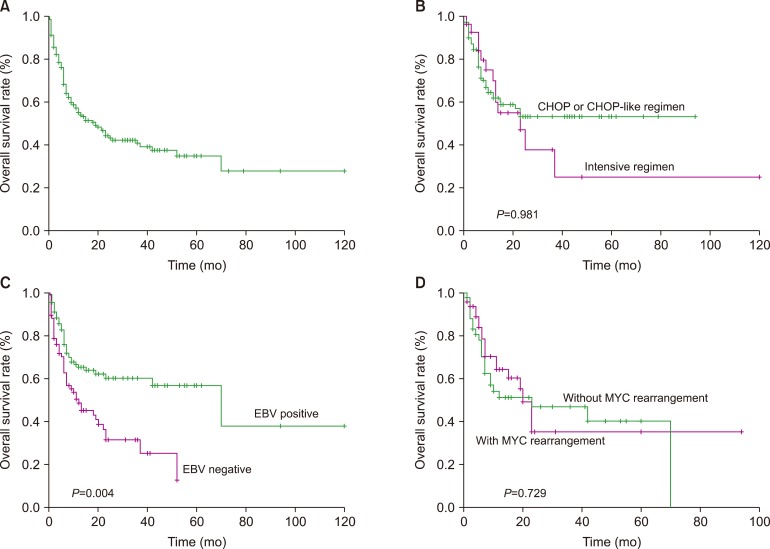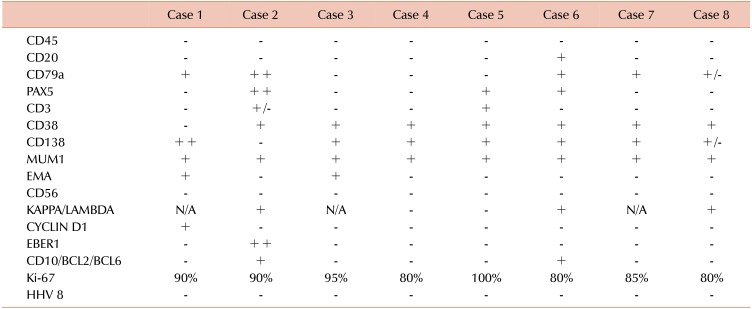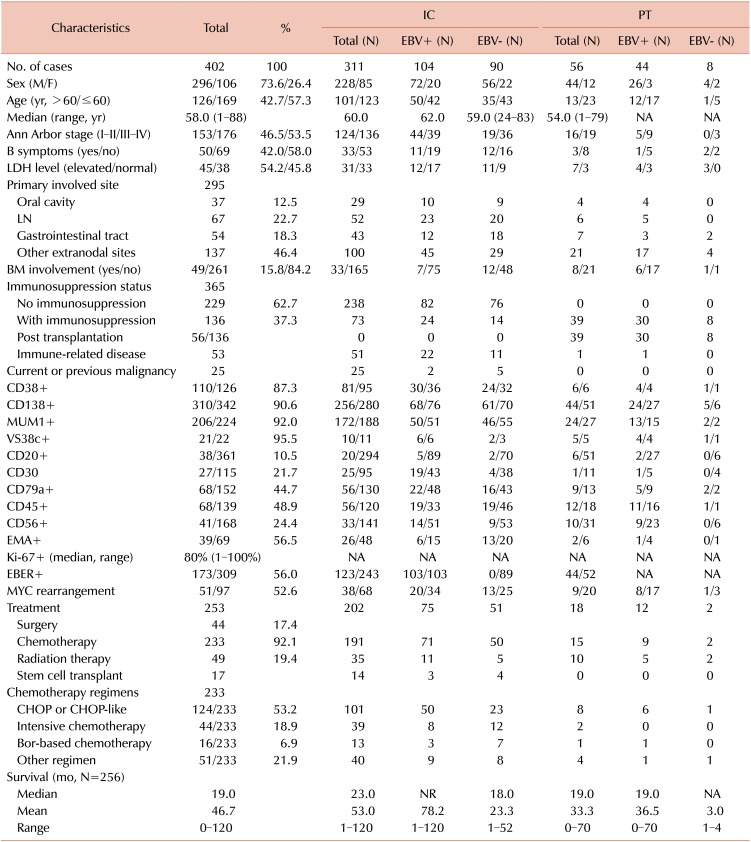1. Campo E, Swerdlow SH, Harris NL, Pileri S, Stein H, Jaffe ES. The 2008 WHO classification of lymphoid neoplasms and beyond: evolving concepts and practical applications. Blood. 2011; 117:5019–5032. PMID:
21300984.

2. Gu X, Zheng R, Xia C, et al. Interactions between life expectancy and the incidence and mortality rates of cancer in China: a population-based cluster analysis. Cancer Commun (Lond). 2018; 38:44. PMID:
29970165.

3. Saba NS, Dang D, Saba J, et al. Bortezomib in plasmablastic lymphoma: a case report and review of the literature. Onkologie. 2013; 36:287–291. PMID:
23689224.

4. Cao C, Liu T, Zhu H, Wang L, Kai S, Xiang B. Bortezomib-contained chemotherapy and thalidomide combined with CHOP (Cyclophosphamide, Doxorubicin, Vincristine, and Prednisone) play promising roles in plasmablastic lymphoma: a case report and literature review. Clin Lymphoma Myeloma Leuk. 2014; 14:e145–e150. PMID:
25225082.

5. Yan M, Dong Z, Zhao F, et al. CD20-positive plasmablastic lymphoma with excellent response to bortezomib combined with rituximab. Eur J Haematol. 2014; 93:77–80. PMID:
24528507.

6. Castillo JJ, Reagan JL, Sikov WM, Winer ES. Bortezomib in combination with infusional dose-adjusted EPOCH for the treatment of plasmablastic lymphoma. Br J Haematol. 2015; 169:352–355. PMID:
25612847.

7. Zanelli M, Ragazzi M, Valli R, et al. Unique presentation of a plasmablastic lymphoma superficially involving the entire large bowel. Pathol Res Pract. 2015; 211:1030–1033. PMID:
26459980.

8. Cencini E, Fabbri A, Guerrini S, Mazzei MA, Rossi V, Bocchia M. Long-term remission in a case of plasmablastic lymphoma treated with COMP (cyclophosphamide, liposomal doxorubicin, vincristine, prednisone) and bortezomib. Eur J Haematol. 2016; 96:650–654. PMID:
26715026.

9. Fedele PL, Gregory GP, Gilbertson M, et al. Infusional dose-adjusted epoch plus bortezomib for the treatment of plasmablastic lymphoma. Ann Hematol. 2016; 95:667–668. PMID:
26801792.

10. Konishi Y, Kaneko H, Nishi K, Imada K. Plasmablastic lymphoma of the gallbladder. Int J Hematol. 2016; 104:1–3. PMID:
27059870.

11. Li F, Ding W, Zuo Z, et al. Plasmablastic lymphoma: a clinico-pathologic analysis of 11 cases with review of literature. Zhonghua Bing Li Xue Za Zhi. 2016; 45:37–42. PMID:
26791552.
12. Han X, Hu LX, Ouyang MQ, Duan MH, Zhou DB. Clinical characteristics and survival analysis of eight cases HIV-negative plasmablastic lymphoma. Zhonghua Xue Ye Xue Za Zhi. 2017; 38:290–294. PMID:
28468089.
13. Lipstein M, O'Connor O, Montanari F, Paoluzzi L, Bongero D, Bhagat G. Bortezomib-induced tumor lysis syndrome in a patient with HIV-negative plasmablastic lymphoma. Clin Lymphoma Myeloma Leuk. 2010; 10:E43–E46. PMID:
21856550.

14. Castillo JJ, Reagan JL. Plasmablastic lymphoma: a systematic review. ScientificWorldJournal. 2011; 11:687–696. PMID:
21442146.

15. Castillo JJ, Furman M, Beltrán BE, et al. Human immunodeficiency virus-associated plasmablastic lymphoma: poor prognosis in the era of highly active antiretroviral therapy. Cancer. 2012; 118:5270–5277. PMID:
22510767.
16. Laurent C, Fabiani B, Do C, et al. Immune-checkpoint expression in Epstein-Barr virus positive and negative plasmablastic lymphoma: a clinical and pathological study in 82 patients. Haematologica. 2016; 101:976–984. PMID:
27175027.

17. Matsuki E, Miyakawa Y, Asakawa S, et al. Identification of loss of p16 expression and upregulation of MDR-1 as genetic events resulting from two novel chromosomal translocations found in a plasmablastic lymphoma of the uterus. Clin Cancer Res. 2011; 17:2101–2109. PMID:
21325069.

18. Montes-Moreno S, Martinez-Magunacelaya N, Zecchini-Barrese T, et al. Plasmablastic lymphoma phenotype is determined by genetic alterations in MYC and PRDM1. Mod Pathol. 2017; 30:85–94.

19. Bogusz AM, Seegmiller AC, Garcia R, Shang P, Ashfaq R, Chen W. Plasmablastic lymphomas with MYC/IgH rearrangement: report of three cases and review of the literature. Am J Clin Pathol. 2009; 132:597–605. PMID:
19762538.
20. Valera A, Balagué O, Colomo L, et al. IG/MYC rearrangements are the main cytogenetic alteration in plasmablastic lymphomas. Am J Surg Pathol. 2010; 34:1686–1694. PMID:
20962620.

21. Liu JJ, Zhang L, Ayala E, et al. Human immunodeficiency virus (HIV)-negative plasmablastic lymphoma: a single institutional experience and literature review. Leuk Res. 2011; 35:1571–1577. PMID:
21752466.

22. Liu M, Liu B, Liu B, et al. Human immunodeficiency virus-negative plasmablastic lymphoma: a comprehensive analysis of 114 cases. Oncol Rep. 2015; 33:1615–1620. PMID:
25695332.

23. Castillo J, Pantanowitz L, Dezube BJ. HIV-associated plasmablastic lymphoma: lessons learned from 112 published cases. Am J Hematol. 2008; 83:804–809. PMID:
18756521.

24. Morscio J, Dierickx D, Nijs J, et al. Clinicopathologic comparison of plasmablastic lymphoma in HIV-positive, immunocompetent, and posttransplant patients: single-center series of 25 cases and meta-analysis of 277 reported cases. Am J Surg Pathol. 2014; 38:875–886. PMID:
24832164.
25. Lin L, Zhang X, Dong M, et al. Human immunodeficiency virus-negative plasmablastic lymphoma: A case report and literature review. Medicine (Baltimore). 2017; 96:e6171. PMID:
28207555.
26. Castillo JJ, Winer ES, Stachurski D, et al. Clinical and pathological differences between human immunodeficiency virus-positive and human immunodeficiency virus-negative patients with plasmablastic lymphoma. Leuk Lymphoma. 2010; 51:2047–2053. PMID:
20919850.

27. Castillo JJ, Bibas M, Miranda RN. The biology and treatment of plasmablastic lymphoma. Blood. 2015; 125:2323–2330. PMID:
25636338.

28. He XH, Li B, Yang S, et al. R-CHOP regimen can significantly decrease the risk of disease relapse and progression in patients with non-germinal center B-cell subtype diffuse large B-cell lymphoma. Chin J Cancer. 2012; 31:306–314. PMID:
22640627.

29. Horwitz SM, Zelenetz AD, Gordon LI, et al. NCCN Guidelines insights: Non-Hodgkin's lymphomas, version 3.2016. J Natl Compr Canc Netw. 2016; 14:1067–1079. PMID:
27587620.
30. Castillo JJ, Winer ES, Stachurski D, et al. Prognostic factors in chemotherapy-treated patients with HIV-associated plasmablastic lymphoma. Oncologist. 2010; 15:293–299. PMID:
20167839.

31. Ye H, Desai A, Gong T, et al. Spontaneous regression of mantle cell lymphoma: a report of four cases. Cancer Commun (Lond). 2018; 38:30. PMID:
29843782.

32. Dittus C, Grover N, Ellsworth S, Tan X, Park SI. Bortezomib in combination with dose-adjusted EPOCH (etoposide, prednisone, vincristine, cyclophosphamide, and doxorubicin) induces longterm survival in patients with plasmablastic lymphoma: a retrospective analysis. Leuk Lymphoma. 2018; 59:2121–2127. PMID:
29303024.

33. Schmit JM, DeLaune J, Norkin M, Grosbach A. A case of plasmablastic lymphoma achieving complete response and durable remission after lenalidomide-based therapy. Oncol Res Treat. 2017; 40:46–48. PMID:
28095384.

34. Holderness BM, Malhotra S, Levy NB, Danilov AV. Brentuximab vedotin demonstrates activity in a patient with plasmablastic lymphoma arising from a background of chronic lymphocytic leukemia. J Clin Oncol. 2013; 31:e197–e199. PMID:
23509308.

35. Bibas M, Grisetti S, Alba L, Picchi G, Del Nonno F, Antinori A. Patient with HIV-associated plasmablastic lymphoma responding to bortezomib alone and in combination with dexamethasone, gemcitabine, oxaliplatin, cytarabine, and pegfilgrastim chemotherapy and lenalidomide alone. J Clin Oncol. 2010; 28:e704–e708. PMID:
20823416.

36. Al-Malki MM, Castillo JJ, Sloan JM, Re A. Hematopoietic cell transplantation for plasmablastic lymphoma: a review. Biol Blood Marrow Transplant. 2014; 20:1877–1884. PMID:
24946718.

37. Nishi K, Mitani S, Hatanaka K, Imada K. Successful cord blood transplantation for an HIV-negative patient with refractory plasmablastic lymphoma. Ann Hematol. 2017; 96:1057–1058. PMID:
28293711.

38. Castillo JJ, Winer ES, Stachurski D, et al. HIV-negative plasmablastic lymphoma: not in the mouth. Clin Lymphoma Myeloma Leuk. 2011; 11:185–189. PMID:
21575922.

39. Tchernonog E, Faurie P, Coppo P, et al. Clinical characteristics and prognostic factors of plasmablastic lymphoma patients: analysis of 135 patients from the LYSA group. Ann Oncol. 2017; 28:843–848. PMID:
28031174.







 PDF
PDF ePub
ePub Citation
Citation Print
Print




 XML Download
XML Download